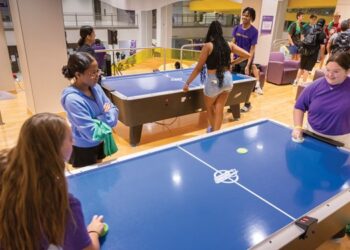You’ve selected the optimal site on campus for your new recreation center. You’ve incorporated spaces and technology in line with the latest recreation and wellness trends. It’s time for a new era of healthier students at your institution. One last thing: have you incorporated environmental graphics?
A dynamic environmental graphics program can really bring recreation and wellness spaces further to life. They help facilities and institutions visually tell stories. They create indelible experiences for students and staff each day. When executed properly, these graphics are far more than just images on the walls. They can bolster overall experience, create new meaningful campus connections, and enhance wellness, brand, fundraising, wayfinding, campus culture and more.
So, how does one execute a successful environmental graphics program for their recreation project? Consider these steps:
Involve Graphics from the Outset
These graphics can positively impact each step in a project’s development and its overall outcomes. And graphics decisions could impact building design or layout decisions as well. It’s always a good idea to strategically think about environmental graphics from Day One, as opposed to after the fact.
Consider Every Element
They truly are more than just images on the wall. They fuse technology, art, imagery, architecture and storytelling to create environments that reinforce brand, shape user experience and connect with audiences. It’s important to consider every medium when developing strong environmental graphics.
Forge Connections
Strong graphics programs are great ways to help foster connections between departments, with the institution’s heritage and future goals in mind. It’s important to engage stakeholders beyond recreation in defining the stories and opportunities.
Engage Students
Environmental graphics will do an even stronger job of enriching student experiences if they’re informed by students. Students can help shed light on wayfinding challenges, ideas to create exciting experiential moments and more. Connecting with them to help identify design possibilities can only enhance the end product.
Ultimately, these graphics have as much potential to transform recreation environments as strong design, optimal daylighting and more. Whether you are renovating or building, there are numerous opportunities for environmental graphics to bolster your effort and strengthen the ultimate solution.
Chris Hayes and Greg Koch are key leaders in CannonDesign’s Environmental Graphics Practice. They’ve helped transform numerous sports, recreation and wellness environments across the country with dynamic graphics and visual storytelling. For more information, visit cannondesign.com.
Image courtesy of CannonDesign










